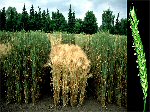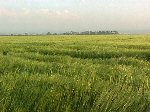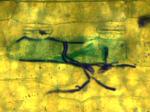CRA- Genomic Research Centre of Fiorenzuola d'Arda
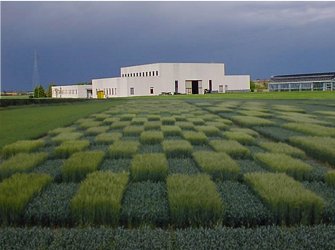 The Genomic Research Centre of Fiorenzuola d'Arda is a public research institute
belonging to the Agricultural Research Council (CRA) of Italy. The Fiorenzuola's
lab is officially responsible of the barley research work in Italy since 1970.
The Centre has developed the largest breeding program of barley in Italy and in
the last two decades more than 10 popular barley varieties have been released.
Marker assisted breeding programmes are currently active to pyramid disease
resistance and quality traits. Technical facilities are available to carry out
experiments in field, glasshouse and growth chambers. The Centre has several labs
dedicated to genomics (molecular markers, gene cloning and microarray analysis),
malting quality and development of cereal based functional foods. A staff of
about 50 people (scientists, technicians and assistant scientific officers) is
employed at Fiorenzuola to cover topic areas as crop physiology, breeding,
genomics of biotic and abiotic stress resistance.
The Genomic Research Centre of Fiorenzuola d'Arda is a public research institute
belonging to the Agricultural Research Council (CRA) of Italy. The Fiorenzuola's
lab is officially responsible of the barley research work in Italy since 1970.
The Centre has developed the largest breeding program of barley in Italy and in
the last two decades more than 10 popular barley varieties have been released.
Marker assisted breeding programmes are currently active to pyramid disease
resistance and quality traits. Technical facilities are available to carry out
experiments in field, glasshouse and growth chambers. The Centre has several labs
dedicated to genomics (molecular markers, gene cloning and microarray analysis),
malting quality and development of cereal based functional foods. A staff of
about 50 people (scientists, technicians and assistant scientific officers) is
employed at Fiorenzuola to cover topic areas as crop physiology, breeding,
genomics of biotic and abiotic stress resistance.
Research relevant for the BarleyGenomeNet
Abiotic stress resistance
 Several approaches have been developed to understand the genetic/molecular bases of
cold and drought resistance and to improve abiotic stress resistance in the new barley
cultivars. Procedures to simulate abiotic stresses under artificial conditions and
evaluation methods are currently employed to study the physiological response of
genotypes for molecular analysis and breeding purposes. A molecular linkage map
deriving from Nure (cold and drought resistant, feeding barley) x Tremois (cold and
drought susceptible, malting barley) has been developed and used to dissect abiotic
stress resistance. QTL analysis has been followed by the identification and analysis
of sets of candidate genes and map-based QTL cloning strategies.
Affymetrix chips and Real Time Q-PCR are currently used for analysis of gene expression
in response to drought and cold at different growth stage up to grain filling in
double haploid barley populations to map expression-QTLs and in barley chloroplast
mutants showing a complete susceptibility to abiotic stresses. We have shown that
barley plants carrying a mutation preventing chloroplast development, beside the
expected albino phenotype, are completely frost susceptible as well as impaired
in the expression of several cor (cold-regulated) genes.
Functional genomic studies are in progress to define the function of genes related
to cold acclimation or dehydration through the identification and the analyses of
A. thaliana homozygous T-DNA knock-out lines carrying an insertion in sequences
homologous to the genes isolated in response to stress in barley.
Several approaches have been developed to understand the genetic/molecular bases of
cold and drought resistance and to improve abiotic stress resistance in the new barley
cultivars. Procedures to simulate abiotic stresses under artificial conditions and
evaluation methods are currently employed to study the physiological response of
genotypes for molecular analysis and breeding purposes. A molecular linkage map
deriving from Nure (cold and drought resistant, feeding barley) x Tremois (cold and
drought susceptible, malting barley) has been developed and used to dissect abiotic
stress resistance. QTL analysis has been followed by the identification and analysis
of sets of candidate genes and map-based QTL cloning strategies.
Affymetrix chips and Real Time Q-PCR are currently used for analysis of gene expression
in response to drought and cold at different growth stage up to grain filling in
double haploid barley populations to map expression-QTLs and in barley chloroplast
mutants showing a complete susceptibility to abiotic stresses. We have shown that
barley plants carrying a mutation preventing chloroplast development, beside the
expected albino phenotype, are completely frost susceptible as well as impaired
in the expression of several cor (cold-regulated) genes.
Functional genomic studies are in progress to define the function of genes related
to cold acclimation or dehydration through the identification and the analyses of
A. thaliana homozygous T-DNA knock-out lines carrying an insertion in sequences
homologous to the genes isolated in response to stress in barley.
Barley resistance to seed-borne pathogens
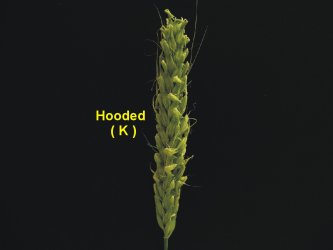 To study barley seed resistance responses we have used the model system of the
interaction between the seed-borne pathogen Pyrenophora graminea, the causal agent
of barley leaf stripe and near-isogenic barley lines with the monogenic resistance gene
Rdg2a. Fluorescent microscopy analysis carried out by using a GUS genetically
transformed isolate of the pathogen defined the histological venue of the resistance
response as at the level of the embryo scutellar node. A join PCR-select and
cDNA-AFLP analysis on these tissues has led to the identification of hundreds of genes
putatively involved in the embryo defence responses that are being validated by
microarray analysis. A positional cloning strategy is underway for cloning of the
Rdg2a resistance gene. After fine mapping of the gene on the chromosome 7H,
the Morex BACs library first and a cosmid library of the donor of the resistance
allele of the gene have been used to define a physical contig of sequences in which
two NBS-LRR candidate genes have been identified. In addition, the mapping of a leaf
stripe resistance gene present in the wild barley Hordeum spontaneum has led to
the identification of a different resistance locus on chromosome 2H. Our interest
on this field of research is currently on the characterization of the resistance
functions of Rdg2a by isolating and expressing the gene in a susceptible
genetic background and in assessing natural genetic variability in the resistance
in cultivated and wild barleys.
To study barley seed resistance responses we have used the model system of the
interaction between the seed-borne pathogen Pyrenophora graminea, the causal agent
of barley leaf stripe and near-isogenic barley lines with the monogenic resistance gene
Rdg2a. Fluorescent microscopy analysis carried out by using a GUS genetically
transformed isolate of the pathogen defined the histological venue of the resistance
response as at the level of the embryo scutellar node. A join PCR-select and
cDNA-AFLP analysis on these tissues has led to the identification of hundreds of genes
putatively involved in the embryo defence responses that are being validated by
microarray analysis. A positional cloning strategy is underway for cloning of the
Rdg2a resistance gene. After fine mapping of the gene on the chromosome 7H,
the Morex BACs library first and a cosmid library of the donor of the resistance
allele of the gene have been used to define a physical contig of sequences in which
two NBS-LRR candidate genes have been identified. In addition, the mapping of a leaf
stripe resistance gene present in the wild barley Hordeum spontaneum has led to
the identification of a different resistance locus on chromosome 2H. Our interest
on this field of research is currently on the characterization of the resistance
functions of Rdg2a by isolating and expressing the gene in a susceptible
genetic background and in assessing natural genetic variability in the resistance
in cultivated and wild barleys.
Barley mutants and genetic materials
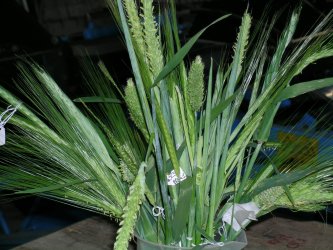 A large collection of about 300 genotypes representing barley chloroplast and
developmental mutants is available at Fiorenzuola d'Arda, affecting both vegetative
and reproductive organs of barley. Both double and triple morphological mutants have
been obtained after crossing mutants carrying single mutations. Moreover, a large
number of mutants have been crossed with the varieties genotypes representing parental
lines of a reference molecular linkage maps. Some mutants have been characterised from a genetical and molecular point of view. This collection provides an invaluable genetic material to dissect patterns of plant development and to allow molecular investigations on genes controlling the plant development.
A large collection of about 300 genotypes representing barley chloroplast and
developmental mutants is available at Fiorenzuola d'Arda, affecting both vegetative
and reproductive organs of barley. Both double and triple morphological mutants have
been obtained after crossing mutants carrying single mutations. Moreover, a large
number of mutants have been crossed with the varieties genotypes representing parental
lines of a reference molecular linkage maps. Some mutants have been characterised from a genetical and molecular point of view. This collection provides an invaluable genetic material to dissect patterns of plant development and to allow molecular investigations on genes controlling the plant development.
Extensive work has been carried out to develop both large segregating populations and sets of near isogenic lines (NILs) that would provide the foundation for isolation and map-based cloning of QTLs and major determinants of barley abiotic stress tolerance (i.e. low temperature and drought tolerance) and the positional cloning of the hulled/naked locus as well as of several chloroplast developmental mutants.
Yeast two-hybrid libraries
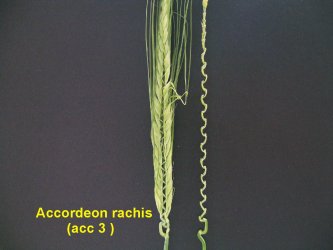 A yeast two-hybrid cDNA library constructed in S cervisiae with mRNA from wheat and barley is available for screening. The library is composed of 1x106 independent clones.
A yeast two-hybrid cDNA library constructed in S cervisiae with mRNA from wheat and barley is available for screening. The library is composed of 1x106 independent clones.
Development of functional foods
The Centre is active in the development of new cereal based foods with improved
nutrient value (functional foods), though an integrated approach involving genetics
(identification of barley mutants and genotypes with high β-glucan or
proanthocyanidins content), technology (from flour to bread and pasta) and breeding
(releasing of new cultivars).
Selected publications
- DAL BOSCO C., M. BUSCONI, C. GOVONI, P. BALDI, A.M. STANCA, C. CROSATTI, R. BASSI, L. CATTIVELLI (2003).
cor gene expression in barley mutants affected in chloroplast development and photosynthetic electron transport.
Plant Physiology, 131: 793-802.
- ARRU L., E. FRANCIA, N. PECCHIONI (2003).
Isolate-specific QTLs of resistance to leaf stripe (Pyrenophora graminea) in the
"Steptoe" x "Morex" spring barley cross.
Theoretical and Applied Genetics, 106(4): 668-675.
- TERZI V., M. MALNATI, M. BARBANERA, A.M. STANCA, P. FACCIOLI (2003).
Development of analytical systems based on real time PCR for Triticum species-specific
detection and quantitation of bread wheat contamination in semolina and pasta.
Journal of Cereal Science, 38: 87-94.
- VÄGÜJFALVI A., G. GALIBA, L. CATTIVELLI, J. DUBCOVSKY (2003).
The cold regulated transcriptional activator Cbf3 is linked to the frost-tolerance gene Fr-A2 on wheat chromosome 5A.
Molecular Genetics and Genomics, 269: 60-67.
- ARRU L., N. FACCINI, C. GOVONI, L. CATTIVELLI, N. PECCHIONI, G. DELOGU, A.M. STANCA, G. VALE' (2003).
The PCR-based marker MWG2018 linked to the Rdg2a leaf stripe resistance gene is a useful tool for assessing barley resistance in breeding programs.
Crop Science, 43: 1036-1042.
- TERZI V., F. INFASCELLI, R. TUDISCO, G. RUSSO, A.M. STANCA, P. FACCIOLI (2004).
Quantitative detection of Secale cereale by real-time PCR amplification.
Food Science and Technology, 37: 239-246.
- CAVALLERO A., A. GIANINETTI, F. FINOCCHIARO, G. DELOGU, A.M. STANCA (2004).
Tocols in hull-less and hulled barley genotypes grown in contrasting environments.
Journal of Cereal Science, 39(2): 175-180.
- FRANCIA E., F. RIZZA, L. CATTIVELLI, A.M. STANCA, G. GALIBA, B. TÖTH, P.M. HAYES, J.S. SKINNER, N. PECCHIONI (2004).
Two loci on chromosome 5H determine low temperature tolerance in a "Nure" (winter) x "Tremois" (spring) barley map.
Theoretical and Applied Genetics, 108: 670-680.
- ROIG C., C. POZZI, L. SANTI, J. MÜLLER, Y. WANG, M.R. STILE, L. ROSSINI. A.M. STANCA, F. SALAMINI (2004).
Genetic of barley Hooded suppression.
Genetics, 167: 439-448.
- MARE' C., E. MAZZUCOTELLI, C. CROSATTI, E. FRANCIA, A.M. STANCA, L. CATTIVELLI (2004).
Hv-WRKY38: a new trascription factor involved in cold- and drought-response in barley.
Plant Molecular Biology, 55: 399-416.
- RIZZA F., F.W. BADECK, L. CATTIVELLI, O. LI DESTRI, N. DI FONZO, A.M. STANCA (2004).
Use of a water stress index to identify barley genotypes adapted to rainfed and irrigated conditions.
Crop Science, 44: 2127-2137.
- TÖTH B., E. FRANCIA, F. RIZZA, A.M. STANCA, G. GALIBA, N. PECCHIONI (2004) .
Development of PCR-based markers of 5H chromosome for assisted selection of frost-tolerant genotypes in barley.
Molecular Breeding, 14: 265-273.
- CAFFARI S., R. CROCE, L. CATTIVELLI, R. BASSI (2004).
A look within LHCII: differential analysis of the Lhcb 1-3 complexes building the major trimeric antenna complex of higher plant photosynthesis.
Biochemistry, 43: 9467-9476.
- BULGARELLI D., N.C. COLLINS, G. TACCONI, E. DALLAGLIO, R. BRUGGEMAN, A. KLEINHOFS, A.M. STANCA, G. VALE' (2004).
High-resolution genetic mapping of the leaf stripe resistance gene Rdg2a in barley.
Theoretical and Applied Genetics, 108: 1401-1408.
- GIANINETTI A., F. TOFFOLI, A. CAVALLERO, G. DELOGU, A.M. STANCA (2005).
Improving discrimination for malting quality in barley breeding programmes.
Field Crop Research, 94(2-3): 189-200.
- MASTRANGELO A.M., S. BELLONI, S. BARILLI, B. RUPERTI, N. DI FONZO, A.M. STANCA, L. CATTIVELLI (2005).
Low temperature promotes intron retention in two e-cor genes of durum wheat.
Planta, 221: 705-715.
- FACCIOLI P., P. PROVERO, C. HERRMAN, A.M. STANCA, C. MORCIA, V. TERZI (2005).
From single genes to co-expression networks: extracting knowledge from barley functional genomics.
Plant Molecular Biology, 58(5): 739-750.
- VON ZITZEWITZ J., P. SZÜCS, J. DUBCOVSKY, L. YAN, E. FRANCIA, N. PECCHIONI, A. CASAS, T.H.H. CHEN, P.M. HAYES, J.S. SKINNER (2005).
Structural and functional characterization of barley vernalization genes.
Plant Molecular Biology, 59: 449-467.
- FRANCIA E., G. TACCONI, C. CROSATTI, D. BULGARELLI, D. BARABASCHI, E. DALL'AGLIO, G. VALE' (2005).
Marker assisted selection in crop plants.
Plant Cell Tissue and Organ Culture, 82: 317-342.
- TONDELLI A., E. FRANCIA, D. BARABASCHI, A. APRILE, J.S. SKINNER, E.J. STOCKINGER, A.M. STANCA, N. PECCHIONI (2006).
Mapping regulatory genes as candidates for cold and drought stress tolerance in barley.
Theoretical and Applied Genetics, 112: 445-454.
- VÄGÜJFALVI A., A. APRILE, A. MILLER, J. DUBCOVSKY, G. DELOGU, G. GALIBA, L. CATTIVELLI (2005).
The expression of several Cbf genes at the Fr-A2 locus is linked to frost resistance in wheat.
Molecular Genetics and Genomics, 274: 506-514.
- SVENSSON J.T., C. CROSATTI, C. CAMPOLI, R. BASSI, A.M. STANCA, T.J. CLOSE, L. CATTIVELLI (2006).
Transcriptome analysis of cold acclimation in barley albina and xantha mutants.
Plant Physiology, 141:257-270.
- TACCONI G., V. BALDASSARRE, N.C. COLLINS, D. BULGARELLI, A.M. STANCA, G. VALE' (2006).
Haplotype characterization and markers at the barley Mlo powdery mildew resistance locus as tools for marker-assisted selection.
Genome, 49: 864-872.
- BARABASCHI D., L. CAMPANI, E. FRANCIA, H. TOUBIA-RAHME, G.P. VALE', A. GIANINETTI, G. DELOGU, A.M. STANCA, N. PECCHIONI (2007).
Haplotype structure around the nud locus in barley and its association with resistance to leaf stripe (Pyrenophora graminea).
Plant Breeding, 125: 24-29.
- FRANCIA E., D. BARABASCHI, A. TONDELLI, G. LAIDO', F. RIZZA, A.M. STANCA, M. BUSCONI, C. FOGHER, E.J. STOCKINGER, N. PECCHIONI (2007).
Fine mapping of a HvCBF gene cluster at the frost resistance locus Fr-H2 in barley.
Theoretical and Applied Genetics, 115:1083–1091.
- Comadran J., J.R. Russell, F.Ä. van Eeuwijk, S. Ceccarelli, S. Grando, M. Baum, A.M. Stanca, E. Francia, N. Secchioni, T. Akar, A. Al-Yassin, A. Benbelkacem, Q. Choumane, H. Ouabbou, D. Rachid, J. Bort, J.-L. Araus, A. Pswarayi, I. Romagosa, C.A. Hackett, W.T.B. Thomas (2007).
Mapping adaptation of barley to droughted environments.
Euphytica, 10.1007/s10681-007-9508-1.
- STOCKINGER E.J., J.S. SKINNER, K.G. GARDNER, E. FRANCIA, N. PECCHIONI (2007).
Expression levels of barley Cbf genes at Frost-resistance-H2 are dependent upon alleles at Fr-H1 and Fr-H2.
The Plant Journal, 51:308-321.
- GIANINETTI A., B. FERRARI, P. FRIGERI, A.M. STANCA (2007).
In vivo modelling of β-glucan degradation in contrasting barley (Hordeum vulgare L.) genotypes.
Journal of Agricultural and Food Chemistry. 55: 3158-3166.

|
 The Genomic Research Centre of Fiorenzuola d'Arda is a public research institute
belonging to the Agricultural Research Council (CRA) of Italy. The Fiorenzuola's
lab is officially responsible of the barley research work in Italy since 1970.
The Centre has developed the largest breeding program of barley in Italy and in
the last two decades more than 10 popular barley varieties have been released.
Marker assisted breeding programmes are currently active to pyramid disease
resistance and quality traits. Technical facilities are available to carry out
experiments in field, glasshouse and growth chambers. The Centre has several labs
dedicated to genomics (molecular markers, gene cloning and microarray analysis),
malting quality and development of cereal based functional foods. A staff of
about 50 people (scientists, technicians and assistant scientific officers) is
employed at Fiorenzuola to cover topic areas as crop physiology, breeding,
genomics of biotic and abiotic stress resistance.
The Genomic Research Centre of Fiorenzuola d'Arda is a public research institute
belonging to the Agricultural Research Council (CRA) of Italy. The Fiorenzuola's
lab is officially responsible of the barley research work in Italy since 1970.
The Centre has developed the largest breeding program of barley in Italy and in
the last two decades more than 10 popular barley varieties have been released.
Marker assisted breeding programmes are currently active to pyramid disease
resistance and quality traits. Technical facilities are available to carry out
experiments in field, glasshouse and growth chambers. The Centre has several labs
dedicated to genomics (molecular markers, gene cloning and microarray analysis),
malting quality and development of cereal based functional foods. A staff of
about 50 people (scientists, technicians and assistant scientific officers) is
employed at Fiorenzuola to cover topic areas as crop physiology, breeding,
genomics of biotic and abiotic stress resistance. Several approaches have been developed to understand the genetic/molecular bases of
cold and drought resistance and to improve abiotic stress resistance in the new barley
cultivars. Procedures to simulate abiotic stresses under artificial conditions and
evaluation methods are currently employed to study the physiological response of
genotypes for molecular analysis and breeding purposes. A molecular linkage map
deriving from Nure (cold and drought resistant, feeding barley) x Tremois (cold and
drought susceptible, malting barley) has been developed and used to dissect abiotic
stress resistance. QTL analysis has been followed by the identification and analysis
of sets of candidate genes and map-based QTL cloning strategies.
Affymetrix chips and Real Time Q-PCR are currently used for analysis of gene expression
in response to drought and cold at different growth stage up to grain filling in
double haploid barley populations to map expression-QTLs and in barley chloroplast
mutants showing a complete susceptibility to abiotic stresses. We have shown that
barley plants carrying a mutation preventing chloroplast development, beside the
expected albino phenotype, are completely frost susceptible as well as impaired
in the expression of several cor (cold-regulated) genes.
Functional genomic studies are in progress to define the function of genes related
to cold acclimation or dehydration through the identification and the analyses of
A. thaliana homozygous T-DNA knock-out lines carrying an insertion in sequences
homologous to the genes isolated in response to stress in barley.
Several approaches have been developed to understand the genetic/molecular bases of
cold and drought resistance and to improve abiotic stress resistance in the new barley
cultivars. Procedures to simulate abiotic stresses under artificial conditions and
evaluation methods are currently employed to study the physiological response of
genotypes for molecular analysis and breeding purposes. A molecular linkage map
deriving from Nure (cold and drought resistant, feeding barley) x Tremois (cold and
drought susceptible, malting barley) has been developed and used to dissect abiotic
stress resistance. QTL analysis has been followed by the identification and analysis
of sets of candidate genes and map-based QTL cloning strategies.
Affymetrix chips and Real Time Q-PCR are currently used for analysis of gene expression
in response to drought and cold at different growth stage up to grain filling in
double haploid barley populations to map expression-QTLs and in barley chloroplast
mutants showing a complete susceptibility to abiotic stresses. We have shown that
barley plants carrying a mutation preventing chloroplast development, beside the
expected albino phenotype, are completely frost susceptible as well as impaired
in the expression of several cor (cold-regulated) genes.
Functional genomic studies are in progress to define the function of genes related
to cold acclimation or dehydration through the identification and the analyses of
A. thaliana homozygous T-DNA knock-out lines carrying an insertion in sequences
homologous to the genes isolated in response to stress in barley. To study barley seed resistance responses we have used the model system of the
interaction between the seed-borne pathogen Pyrenophora graminea, the causal agent
of barley leaf stripe and near-isogenic barley lines with the monogenic resistance gene
Rdg2a. Fluorescent microscopy analysis carried out by using a GUS genetically
transformed isolate of the pathogen defined the histological venue of the resistance
response as at the level of the embryo scutellar node. A join PCR-select and
cDNA-AFLP analysis on these tissues has led to the identification of hundreds of genes
putatively involved in the embryo defence responses that are being validated by
microarray analysis. A positional cloning strategy is underway for cloning of the
Rdg2a resistance gene. After fine mapping of the gene on the chromosome 7H,
the Morex BACs library first and a cosmid library of the donor of the resistance
allele of the gene have been used to define a physical contig of sequences in which
two NBS-LRR candidate genes have been identified. In addition, the mapping of a leaf
stripe resistance gene present in the wild barley Hordeum spontaneum has led to
the identification of a different resistance locus on chromosome 2H. Our interest
on this field of research is currently on the characterization of the resistance
functions of Rdg2a by isolating and expressing the gene in a susceptible
genetic background and in assessing natural genetic variability in the resistance
in cultivated and wild barleys.
To study barley seed resistance responses we have used the model system of the
interaction between the seed-borne pathogen Pyrenophora graminea, the causal agent
of barley leaf stripe and near-isogenic barley lines with the monogenic resistance gene
Rdg2a. Fluorescent microscopy analysis carried out by using a GUS genetically
transformed isolate of the pathogen defined the histological venue of the resistance
response as at the level of the embryo scutellar node. A join PCR-select and
cDNA-AFLP analysis on these tissues has led to the identification of hundreds of genes
putatively involved in the embryo defence responses that are being validated by
microarray analysis. A positional cloning strategy is underway for cloning of the
Rdg2a resistance gene. After fine mapping of the gene on the chromosome 7H,
the Morex BACs library first and a cosmid library of the donor of the resistance
allele of the gene have been used to define a physical contig of sequences in which
two NBS-LRR candidate genes have been identified. In addition, the mapping of a leaf
stripe resistance gene present in the wild barley Hordeum spontaneum has led to
the identification of a different resistance locus on chromosome 2H. Our interest
on this field of research is currently on the characterization of the resistance
functions of Rdg2a by isolating and expressing the gene in a susceptible
genetic background and in assessing natural genetic variability in the resistance
in cultivated and wild barleys. A large collection of about 300 genotypes representing barley chloroplast and
developmental mutants is available at Fiorenzuola d'Arda, affecting both vegetative
and reproductive organs of barley. Both double and triple morphological mutants have
been obtained after crossing mutants carrying single mutations. Moreover, a large
number of mutants have been crossed with the varieties genotypes representing parental
lines of a reference molecular linkage maps. Some mutants have been characterised from a genetical and molecular point of view. This collection provides an invaluable genetic material to dissect patterns of plant development and to allow molecular investigations on genes controlling the plant development.
A large collection of about 300 genotypes representing barley chloroplast and
developmental mutants is available at Fiorenzuola d'Arda, affecting both vegetative
and reproductive organs of barley. Both double and triple morphological mutants have
been obtained after crossing mutants carrying single mutations. Moreover, a large
number of mutants have been crossed with the varieties genotypes representing parental
lines of a reference molecular linkage maps. Some mutants have been characterised from a genetical and molecular point of view. This collection provides an invaluable genetic material to dissect patterns of plant development and to allow molecular investigations on genes controlling the plant development. A yeast two-hybrid cDNA library constructed in S cervisiae with mRNA from wheat and barley is available for screening. The library is composed of 1x106 independent clones.
A yeast two-hybrid cDNA library constructed in S cervisiae with mRNA from wheat and barley is available for screening. The library is composed of 1x106 independent clones.
